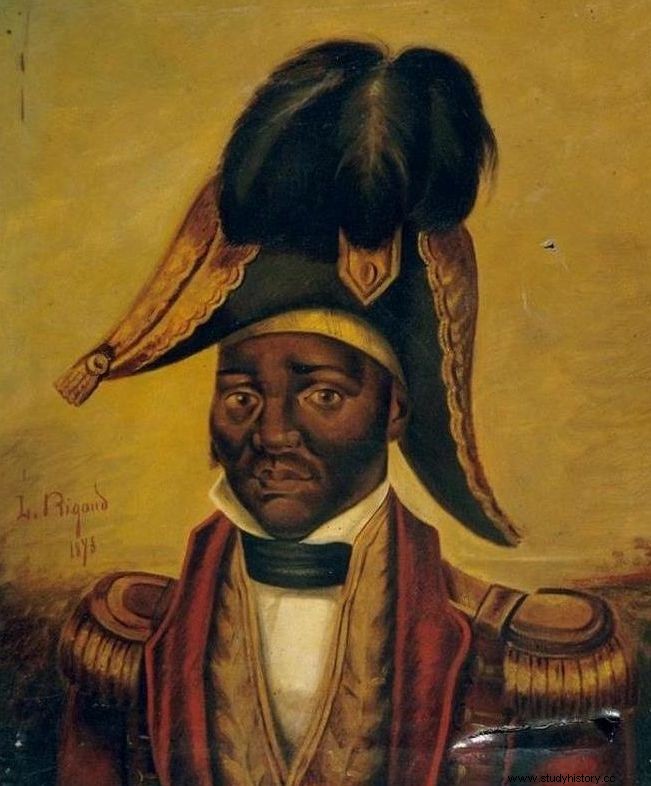Wife of Jean-Jacques Dessalines, Marie-Claire Bonheur (1758 – 1858) was Empress of Haiti at the beginning of the 19th century.

Marie-Claire’s childhood
Daughter of Marie-Sainte Lobelot and Guillaume Bonheur, Marie-Claire Heureuse Félicité Bonheur was born in 1758 in Léogâne, in the south of Haiti, into a poor but free family. She was educated by her aunt Élise Lobelot, governess of a religious order.
At the time and since 1626, Haiti is a French colony called Saint-Domingue. The settlers developed plantations of tobacco, indigo, sugar cane and coffee there. Alongside French people fleeing poverty, these plantations mainly exploit many black slaves from the triangular trade. At the time of Marie-Claire's birth, Santo Domingo, the richest colony in the West Indies, had approximately 200,000 slaves. The cruelty of slavery, the deep inequalities of Santo Domingo society, the strict control of the metropolis over the trade of the colony, carry the seeds of revolt.
Marie-Claire married Pierre Lunic, master wheelwright (craftsman specializing in wood and metal, manufacturing and maintaining vehicles such as carts and wagons). Her husband died in 1795 and Marie-Claire became a widow.
The Haitian Revolution and the Siege of Jacmel
On the eve of the Haitian revolution, rising tensions made the situation in Santo Domingo explosive. Black slaves seek freedom from the cruelty of slavery; the white settlers want to get rid of the control of the metropolis; finally, free blacks and mestizos, freed or born of free parents, demand equality with whites. When the French Revolution started, the colonists saw it as an opportunity to gain more autonomy and obtained six deputies in the Constituent Assembly. Defending their interests, they oppose equal rights and the abolition of slavery that is looming. Tensions escalate and the first violence breaks out.
In August 1791, Dutty Boukman, a slave and houngan (a priest of the voodoo religion), organized alongside the Mambo priestess Cécile Fatiman a ceremony in Bois-Caïman, which was the starting point of a slave revolt. In about ten days, nearly 1,000 whites were killed and 1,800 plantations destroyed. The revolt turns into a war of independence, under the leadership of Toussaint Louverture in particular. Initially allied with the Spaniards, Toussaint Louverture changed sides when France abolished slavery in 1794 and joined the French.
From 1799, the war of the knives opposed Toussaint Louverture and André Rigaud, two warlords of the Haitian revolution, but also blacks and mulattoes. The struggle of the two men for power and control of the territory led them to clash in Jacmel in 1800. Marie-Claire Bonheur stood out there for her actions in favor of the wounded and the starving. She convinces Jean-Jacques Dessalines, lieutenant of Toussaint Louverture and besieger of the city, to open roads to allow the arrival of aid. She can thus bring in food, clothes and medicines, and organizes meals in the street.
Jean-Jacques Dessalines
In April 1800, Marie-Claire married Jean-Jacques Dessalines in Léogâne, with whom she had a long-standing relationship. The couple already have several children; they will have seven in total. Marie-Claire also legitimizes her husband's children born to his previous mistresses, including Catherine Flon, considered one of the four heroines of the Haitian revolution.

In 1801, Toussaint Louverture was proclaimed governor for life of Haiti. In response, Napoleon decided to send an expedition to Santo Domingo, officially to restore order but above all to restore slavery. Jean-Jacques Dessalines contributes to the resistance against the French expedition. Defeated, he surrenders to the French and participates in the arrest of Toussaint Louverture, who will be exiled. When the news of the restoration of slavery spreads, a new revolt breaks out, in which Jean-Jacques Dessalines joins. In 1804, he proclaimed the independence of Santo Domingo, to which he gave back its Indian name of Haiti. He was appointed governor general for life, then emperor of Haiti under the name of Jacques I; Marie-Claire thus becomes Empress of Haiti.
A merciful Empress
Following the proclamation of the independence of Haiti, Jean-Jacques Dessalines gives the order to massacre the white men still present on the island; the massacres extend to women and children, and are accompanied by looting and rape. The killings will cause between 3,000 and 5,000 victims.
Described as merciful, kind, warm, Empress Marie-Claire Bonheur was very opposed to her husband's policy. In particular, she would have fallen on her knees in front of him to beg him to spare the white French people of Haiti. She provides for the needs of the prisoners, and saves some people threatened with massacre by hiding them and organizing their escape.
Marie-Claire thus participates in the rescue of the "Cape orphans", Hortense and Augustine de Saint-Janvier. First hidden by a black servant from their parents, the 8 and 5-year-old girls are spared by a general, protected by former slaves and then taken in by the Empress. She herself organizes their repatriation to France.
The fall
In 1806, Jacques I st is overthrown and assassinated. Henri Christophe, leader of the insurrection, offers hospitality to Marie-Claire Bonheur and her children but she refuses. Her husband's possessions having been confiscated, she lived in poverty until she was granted a pension in 1843.
Out of admiration for her late husband, the Emperor of Haiti Faustin I crowned in 1849 decided to increase his pension, but Marie-Claire refused the money. She moved in with her granddaughter, living in poverty until her death in August 1858, aged over 100.
